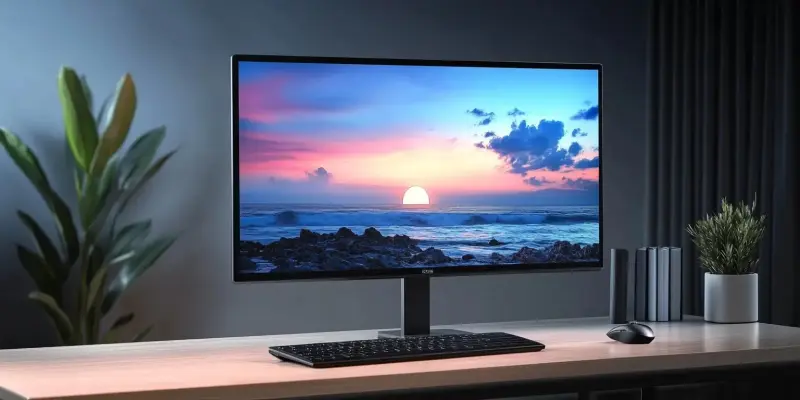The article delves into the feasibility of using OLED monitors for long-term productivity tasks by examining the performance of the MSI QD-OLED monitor over a year of rigorous testing. The study aims to determine if OLED displays can handle extended periods of static content without significant burn-in, a common concern for productivity use.
Initial Setup and Testing Rationale
Selecting the Monitor
The MSI 4K 240Hz QD-OLED monitor was chosen for its high brightness and refresh rate, which are factors that could potentially worsen burn-in. The goal was to assess whether OLED can sustain long-term productivity use akin to traditional LCD screens, which are known for their durability against burn-in. Combining high resolution with impressive refresh rates, this monitor presents an epitome of OLED capabilities.
Testing Conditions
The monitor was subjected to over 8 hours of continuous static content daily, simulating typical productivity tasks and exposing the display to static elements that are known to accelerate burn-in. The simulation of these conditions intended to replicate the challenges encountered in a productivity environment, where prolonged exposure to static content, such as text documents, web pages, and video editing interfaces, can be common. By neglecting the standard preventive measures, the test offered an unfiltered look into the burn-in tendencies under non-ideal conditions. The conscious choice of excluding dark mode, screensavers, and brightness reduction aimed to assess the OLED’s raw resilience, thereby yielding a realistic expectation for users regarding its durability and maintenance needs.
Progression of Burn-In Observations
Early Stages
One Month (200-250 hours): After one month of continuous use, no significant signs of burn-in were observed, suggesting an initial resilience of the OLED panel under continuous static exposure.
Three Months (650-750 hours, 71 compensation cycles): Over three months, faint signs of burn-in began to emerge, marking the early stages of subpixel degradation but still remaining minor. The early detection of these symptoms underlined the gradual onset process typical for OLED technology, indicating that while resilient initially, OLED displays do start showing signs of burn-in over prolonged static usage.
Mid-Term Observations
Six Months (1,200-1,500 hours, 141 compensation cycles): By six months, burn-in became more noticeable but remained minor, signaling a gradual increase in visibility while staying within a manageable threshold.
Nine Months (2,000-2,300 hours, 224 compensation cycles): Despite increased usage, the burn-in progression was relatively stable, indicating a slower than expected degradation rate. This stability suggested that after an initial phase of susceptibility, the rate of burn-in might plateau, providing a more extended period of usability.
Detailed Findings and Analysis
Visibility of Burn-In
Burn-in was predominantly noticeable on dark gray backgrounds, particularly in applications like Adobe Premiere. In lighter backgrounds or more dynamic content, such as videos or white web pages, burn-in remained practically undetectable, underscoring the variable impact based on usage patterns.
Subpixel Degradation
The green subpixel was the most affected, contributing significantly to visible image retention in grayscale tests. This disparity among subpixels suggested a variable rate of degradation, likely influenced by the inherent properties of each color’s organic compounds. In contrast, the red subpixel showed no visible burn-in, while the blue subpixel had slight but less noticeable degradation, highlighting a more complex pattern of wear.
Mitigation and Compensation
Compensation Cycles
Although compensation cycles were performed less frequently than recommended, they seemed effective in reducing the visibility of burn-in symptoms over time. The uniformity of burn-in symptoms pointed to a relatively stable subpixel aging process, except for the slightly diminishing output of the green subpixel, which highlights the importance of tailored compensation strategies. Regular adherence to recommended compensation intervals could significantly delay the progression of burn-in, hence offering a more stable long-term use experience.
Brightness Consistency
The monitor’s brightness remained consistent at 243 nits, unaffected by the number of compensation cycles. The consistency in brightness was a positive outcome, demonstrating that burn-in did not fundamentally impair the primary display attributes, preserving the monitor’s usability.
Practical Use Implications
User Experience
The user experience suggested adaptation to the faint burn-in, especially when the brain tunes out static elements after prolonged exposure. This showcases the resilience and durability of OLED technology for productivity work, even under extreme conditions. Users found that after initial adjustments, the faint burn-in did not significantly detract from their productivity, establishing OLED monitors as viable options for extended use. The capacity for the human brain to filter out static artifacts over time played a crucial role in mitigating the practical impact of burn-in.
Cumulative Hour Analysis
The article explores the practicality of utilizing OLED monitors for lengthy productivity tasks, with a focus on the MSI QD-OLED monitor. The research spans over a year of thorough testing to evaluate the monitor’s performance. One of the primary concerns being addressed is whether OLED displays can endure extended periods of static content without experiencing significant burn-in.
Throughout the year-long assessment, various aspects of the MSI QD-OLED’s durability and functionality were examined. The study scrutinizes if the quality and reliability of the OLED monitor can meet the rigors of everyday productivity without degrading.
The findings from this extensive evaluation aim to provide a clearer understanding of the suitability of OLED technology for work-related applications. By focusing on real-world usage patterns and the potential risks of burn-in, the article offers valuable information for those contemplating the shift from traditional LCD displays to OLED monitors.

